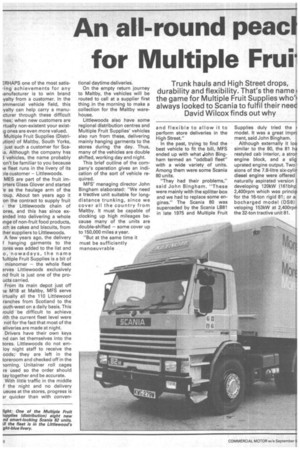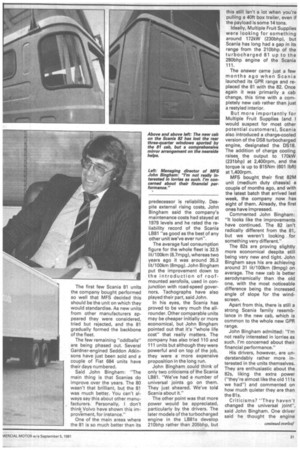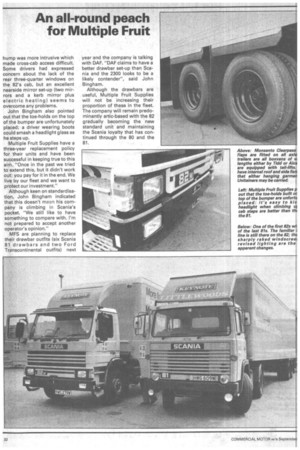An all-round peac for Multiple Frui
Page 22

Page 23

Page 24

If you've noticed an error in this article please click here to report it so we can fix it.
Trunk hauls and High Street drops, durability and flexibility. That's the name the game for Multiple Fruit Supplies who" always looked to Scania to fulfil their need David Wilcox finds out why
:7-RHAPS one of the most satisring achievements for any Eanufacturer is to win brand yalty from a customer. In the )mmercial vehicle field, this yalty can help carry a menucturer through these difficult -nes; when new customers are rtually non-existent your exist ones are even more valued. Multiple Fruit Supplies (DistriJtion) of Maltby, South Yorks, just such a customer for Scala. Although the company has 3 vehicles, the name probably :on't be familiar to you because ie fleet runs in the livery of its ale customer — Littlewoods. MES are part of the fruit imDrters Glass Glover and started 'e as the haulage arm of the ,oup. About ten years ago it on the contract to supply fruit the Littlewoods chain of ores, and this has since ex3nded into delivering a whole Inge of non-fruit food products, J ch as cakes and biscuits, from ther suppliers to Littlewoods. A few years ago, the delivery f hanging garments to the bores was added to the list and o, nowadays, the name lultiple Fruit Supplies is a bit of misnomer — the whole fleet erves Littlewoods exclusively nd fruit is just one of the proucts carried.
From its main depot just off le M18 at Maltby, MFS serve irtually all the 110 Littlewood ranches from Scotland to the outh-west on a daily basis. This rould be difficult to achieve rith the current fleet level were not for the fact that most of the eliveries are made at night.
Drivers have their own keys nd can let themselves into the tores. Littlewoods do not em by night staff to receive the oods; they are left in the
toreroom and checked off in the -taming. Unitainer roll cages re used so the order should tay together and be accurate.
With little traffic in the middle f the night and no delivery
ueues at the stores, progress is 3r quicker than with conven
tional daytime deliveries.
On the empty return journey to Maltby, the vehicles will be routed to call at a supplier first thing in the morning to make a collection for the Maltby warehouse.
Littlewoods also have some regional distribution centres and Multiple Fruit Supplies' vehicles also run from these, delivering mainly hanging garments to the stores during the day. Thus, many of the vehicles are double shifted, working day and night.
This brief outline of the cornpany's operation gives an indication of the sort of vehicle required.
MFS' managing director John Bingham elaborated: "We need a tractive unit suitable for longdistance trunking, since we cover all the country from Maltby. It must be capable of clocking up high mileages because many of the units are double-shifted — some cover up to 150,000 miles a year.
"But at the same time it must be sufficiently manoeuvrable and flexible to allow it to perform store deliveries in the High Street."
In the past, trying to find the best vehicle to fit the bill, MFS ended up with what *John Bingham termed an "oddball fleet" with a wide variety of units. Among them were some Scania 80 units.
"They had their problems," said John Bingham. "These were mainly with the splitter-box and we had to replace some engines." The Scania 80 was superceded by the Scania LB81 in late 1975 and Multiple Fruit
Supplies duly tried the t model. It was a great imprc ment, said John Bingham.
Although externally it loo similar to the 80, the 81 ha restyled cab interior, a stror engine block, and a slig uprated engine output. Two sions of the 7.8-litre six-cylin diesel engine were offered naturally aspirated version ( developing 120kW (161bhp: 2,400rpm which was princip for the 16-ton rigid 81; or a bocharged model (DS8) veloping 153kW at 2,400rpnr the 32-ton tractive unit 81.
The first few Scania 81 units the company bought performed so well that MFS decided this should be the unit on which they would standardise. As new units from other manufacturers appeared they were considered, tried but rejected, and the 81 gradually formed the backbone of the fleet.
The few remaining "oddballs" are being phased out. Several Gardner-engined Seddon Atkinsons have just been sold and a couple of Fiat 684 units have their days numbered.
Said John Bingham: "The main thing is that Scanias do improve over the years. The 80 wasn't that brilliant, but the 81 was much better. You can't always say this about other manufacturers. Personally, I don't think Volvo have shown this improvement, for instance."
One of the main areas where the 81 is so much better than its predecessor is reliability. Despite external rising costs, John Bingham said the company's maintenance costs had stayed at 1979 levels and he rated the reliability record of the Scania LB81 "as good as the best of any other unit we've ever run".
The average fuel consumption figure for the whole fleet is 32.5 lit/100km (8.7mpg), whereas two years ago it was around 35.3 lit/100km (8mpg). John Bingham put the improvement down to the introduction of roofmounted aerofoils, used in conjunction with road-speed governors. Tachographs have also played their part, said John.
In his eyes, the Scania has proved to be very much the allrounder. Other comparable units may be cheaper initially or more economical, but John Bingham pointed out that it's "whole life cost" that really matters. The company has also tried 110 and 111 units but although they were powerful and on top of the job, they were a more expensive proposition in the long run.
John Bingham could think of only two criticisms of the Scania LB81. "We've had a number of universal joints go on them. They just sheared. We've told Scania about it."
The other point was that more power would be appreciated, particularly by the drivers. The later models of the turbocharged engine in the LB81s develop 210bhp rather than 205bhp, but this still isn't a lot when you're pulling a 40ft box trailer, even if the payload is some 14 tons.
Ideally, Multiple Fruit Supplies were looking for something around 172kW (230bhp), but Scania has long had a gap in its range from the 210bhp of the turbocharged 81 up to the 280bhp engine of the Scania 111.
The answer came just a few months ago when Scania launched its GPR range and replaced the 81 with the 82. Once again it was primarily a cab change, this time with a completely new cab rather than just a restyled interior.
But more importantly for Multiple Fruit Supplies (and I would suspect for most other potential customers), Scania also introduced a charge-cooled version of the DS8 turbocharged engine, designated the DS18. The addition of charge cooling raises, the output to 170kW (231bhp) at 2,400rpm, and the torque is up to 815Nm (601 lbft) at 1,400rpm.
MFS bought their first 82M unit (medium duty chassis) a couple of months ago, and with the latest batch that arrived last week, the company now has eight of them. Already, the first ones have impressed.
Commented John Bingham: "It looks like the improvements have continued. The 82 isn't radically different from the 81, but we weren't looking for something very different."
The 82s are proving slightly more economical despite still being very new and tight. John Bingham says his are achieving around 31 lit/100km (9mpg) on average. The new cab is better aerodynamically than the old one, with the most noticeable difference being the increased angle of slope for the windscreen.
Apart from this, there is still a strong Scania family resemblance in the new cab, which is common to the whole new GPR range.
John Bingham admitted: "I'm not really interested in lorries as such. I'm concerned about their financial performance."
His drivers, however, are understandably rather more interested in the units themselves. They are enthusiastic about the 82s, liking the extra power ("they're almost like the old ills we had") and commented on how much quieter they are than the 81s.
Criticisms? "They haven't changed the universal joint", said John Bingham. One driver said he thought the engine hump was more intrusive which made cross-cab access difficult. Some drivers had expressed concern about the lack of the rear three-quarter windows on the 82's cab, but an excellent nearside mirror set-up (two mirrors and a kerb mirror plus electric heating) seems to overcome any problems.
John Bingham also pointed out that the toe-holds on the top of the bumper are unfortunately placed; a driver wearing boots could smash a headlight glass as he steps up.
Multiple Fruit Supplies have a three-year replacement policy for their units and have been successful in keeping true to this aim. "Once in the past we tried to extend this, but it didn't work out: you pay for it in the end. We live by our fleet and we want to protect our investment."
Although keen on standardisation, John Bingham indicated that this doesn't mean his company is climbing in Scania's pocket. "We still like to have something to compare with. I'm not prepared to accept another operator's opinion."
MFS are planning to replace their drawbar outfits (six Scania 81 drawbars and two Ford Transcontinental outfits) next year and the company is talking with DAF. "DAF claims to have a better drawbar set-up than Scania and the 2300 looks to be a likely contender", said John Bingham.
Although the drawbars are useful, Multiple Fruit Supplies will not be increasing their proportion of these in the fleet. The company will remain predominantly artic-based with the 82 gradually becoming the new standard unit and maintaining the Scania loyalty that has continued through the 80 and the 81.








































